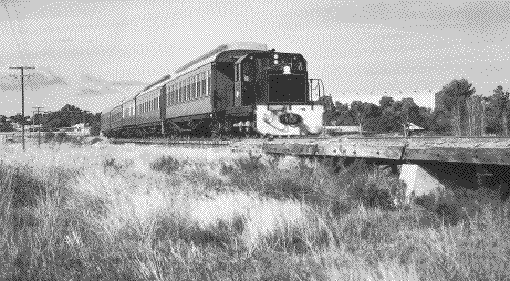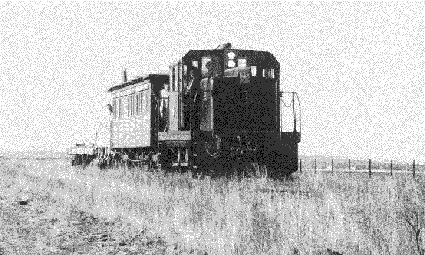Photos and text © Nic Doncaster

NC1 with a Steamtown Passenger train, just out of Peterborough
Photos and text © Nic Doncaster

NC1 with a Steamtown Passenger train, just out of Peterborough
The small units of, under their final ownership, the NC class are one such group of locomotives. These diminutive Clydes worked on lines in WA, SA and the Northern Territory.
Ordered in 1954 from the Clyde Engineering Company, the locomotives were built to a modified design advertised by Clyde as their DH class. Their first owners being the Lakewood Firewood Company (LFC).
Lakewood was a timber supply company that provided wood to the "Golden Mile" for use both as mine timbers and as firewood in the many boilers around the district. The company ran a lease working south of Kalgoorlie past Lake Lefroy, and at the greatest extent almost to the Eyre Highway. The company worked over 190km of 1067mm track.
Railway Transportation (June 1957) ran a two page spread regarding the introduction of these units to the service of LFC.
The headline read "New General Purpose Loco: Prototype units on 109 mile haul". These units were coded by Clyde as the DH-110. The basic design from which they were drawn was intended for service in any gauge over a metre.
Power is drawn from a General Motors 6-110 series two stroke diesel unit. This puts out 300hp, of which 250 horses are available for traction. This gave them a power 20% less that that of a WAGR "W" (76kn v 96kn).
Maximum design speed was 35mph and were built with dual control desks, so they could be operated up to full power in either direction from each driving station.
Although not fitted to either of the units, the series could be fitted with dynamic brakes, a combination of air and vacuum brakes, and multiple unit control equipment.
NC1 is noted as having MU facilities, but it is not known if this was done during the construction of the unit, or as a later modification be either CR or LFC.
At the same time that the LFC units were being built, Clyde was also building sister DH units for the sugar mills in Queensland. These units, classes as DH1-71 series, would go on to number a total of 33. Other than size, the main difference was engine power: the smaller tram engines running GM 71 series engines, the LFC units running GM 110 series plants.
Sadly, by the time the two engines had arrived, the downturn in wood traffic had reduced services to twice a week. A stark contrast to the two trains a day that had once been run.
However, the engines were pressed into service, and the remaining steam locomotives were withdrawn from service. They performed well and were noted as very reliable.They were unpopular with crews however "only because they were diehard steam men".
This attitude led the company to resteam two locomotives for use as yard shunters at Lakewood.
The ongoing downturn in the wood industry saw Lakewood reduce its work force to fifty by 1962, a far cry from the 550 employed nine years earlier. Thus the writing was on the wall.
Lakewood ran its last train on December 22, 1964 to clean up the system. The companys' assets were later sold for scrap, including its fleet of steam locomotives.
The two diesel engines were eventually purchased by the then Commonwealth Railways in 1965 and began service in 1966.
They spent a short period in the Port Augusta Workshops where the (WAGR) vacuum braking system was removed, and CR's Westinghouse air brake equipment was installed on NC1. NC1 was also repainted in CR colours of silver and maroon. The "new" NC2 remained in LFC colours and had its class painted in the former LFC roundel . Interestingly, it seems NC1 received all the work, whilst NC2 remained without air brakes for the rest of its life with the CR.
Whilst the work was being undertaken, an earlier modification the the air intake system on No1 was removed. This appears to be an early LFC modification as evidence exists in an edition of "Railway Transportation" which included an advertisement that described the units.
It is not known whether the locomotives were fitted with the necessary equipment during construction, or if the Commonwealth Railways undertook to install multiple unit (MU) equipment, as indicated by the two smaller hoses seen on NC1, when they arrived in Port Augusta (one source suggests that this was done by the CR); one hose operates the forward/reverse selector, the other the throttle. It is interesting to note that the MU piping was installed at one end of NC1 only.

NC1, AV16, a YY and a Flat Top on a Steamtown Work Train near Black Rock, April 25, 1995
The CR did give serious consideration to MU operation of the locomotives on the Hawker line. This would have led to the discontinuance of steam (the hired "T" class). Given that NC2 remained with vacuum brakes, it is highly improbable that they ever worked together with the CR. As the class was a grand total of two units, the need to MU from either end was certainly diminished.
After receiving the modifications at Port Augusta, NC1 was sent to the Northern Australia Railway in November 1966, where it was employed as Yard Shunter.
Whilst its sister was employed in the tropics, NC2 remained in Port Augusta as yard shunter until 1970, when former steam engine NB30 returned from her duties on the old Hawker line.
NC1 returned south in early 1972, and displaced NB30 from her work. In order to keep NC1 running, parts were slowly removed from NC2.
With the closure of the narrow gauge Central Australia System in late 1980, NC1's role became less and less important. By early 1982, the engine was practically abandoned.
NC2 left Port Augusta for Quorn in July 1982. After several months of child-proofing, NC2 was repainted in LFC cream and green, and on the road to Port Lincoln, where in November 1982, she was swapped for Yx141.
NC1 remained with the Australian National Railways Commission until 1985, when AN approached Steamtown for several of its tanker cars. This happened in response to an increase in the Mereenie crude oil traffic on the CAR . An agreement was reached and NC1 was transferred arriving in Peterborough on April 15, 1985.
Some work was undertaken on NC1 to return her to traffic, including the replacement of bearings in her gearbox.
NC1 has been perhaps the most important of Steamtowns fleet over the years, including its sole source of power for a period between 1993 and 1995. She was repainted in CR colours in April 1998.
Meanwhile, her sister remains in Port Lincoln, though there has been interest in removing her from the Park. During 2008, modifications were made by the Port Lincoln Council to improve child safety. The cab has been enclosed with steel plate, and the locomotive repainted.
With the demise of Steamtown, NC1 is no longer operated. She remains as part of the "Steamtown Heritage Precinct". Some commentators have noted that NC1 would still be usable with some minor works.
Originally published in "The Partyline", in-house magazine of the now defunct Steamtown, Peterborough Railway Preservation Society Inc.
(Copies of the article can be provided on request)
The Sulzer | Y82 | BHP Port Lincoln Operations | Section Cars | Crossley/X
© Nic Doncaster Images, Content and layout.
Uploaded December 2001, updated November 8, 2008